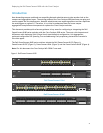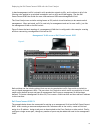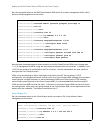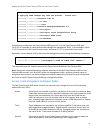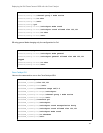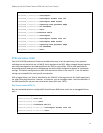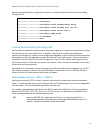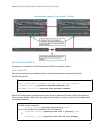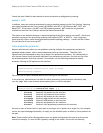
Deploying the Dell PowerConnect 8100 with the Cisco Catalyst
8
cat6504E_1(config-vlan)#exit
% Applying VLAN changes may take few minutes. Please wait...
cat6504E_1(config)#interface vlan 50
cat6504E_1(config-if)#no shut
cat6504E_1(config-vlan)#exit
cat6504E_1(config)#interface TenGigabitEthernet 2/1
cat6504E_1(config-if)#switchport
cat6504E_1(config-if)#switchport trunk encapsulation dot1q
cat6504E_1(config-if)#switchport mode trunk
cat6504E_1(config-if)#no shutdown
By connecting a cable from the Cisco Catalyst 6500 (port te2/1) to the PowerConnect 8100 (port
te1/0/23) it is possible to reach both switches through the management VLAN. In this example, telnet
5.5.5.5 to access the Dell PowerConnect switch, and telnet 5.5.5.7 to access the Cisco switch.
Optionally, remove default VLAN traffic from the management ports by using the following commands:
console(config-if-Te1/0/23)# switchport trunk allowed vlan remove 1
cat6504E_1(config-if)#switchport trunk allowed vlan remove 1
This command works the same on both the Dell PowerConnect 8100 and Cisco Catalyst 6500.
Note: Other basic setup configurations might be necessary for the Dell PowerConnect 8100 or Cisco
Catalyst 6500 switches, such as a DHCP option for management VLANs, assigning a domain server or
assigning a domain name, but these configuration steps are essentially the same for both switches and
are found in the Dell PowerConnect 8100 User Configuration Guide.
Access, trunk and general Switchport Modes
The Dell PowerConnect 8100 series switches can have each port configured in one of the following
modes (Dell.com, 2012):
Access
Access ports are intended to connect end devices to the switch or network. Many
times these end devices are PCs (personal computers) that cannot generate VLAN
tags on their network device link. Access ports only have one VLAN and any
traffic on this port is sent and received with no VLAN tagging. With an access
port, incoming tagged packets are dropped, and any VLAN information is cleared
from the frame before it is sent to an end device.
Trunk
Trunk-mode ports are intended to link switches together. Trunk ports work with
both tagged and untagged packets. Tagged packets received on a trunk port are
forwarded on the VLAN contained in the tag. Untagged packets are forwarded on
the native VLAN. Trunk mode includes all VLANs by default.
General
This mode is specific to the PowerConnect switches. Ports in general mode are
either access and/or trunk ports depending on their tagged state.






